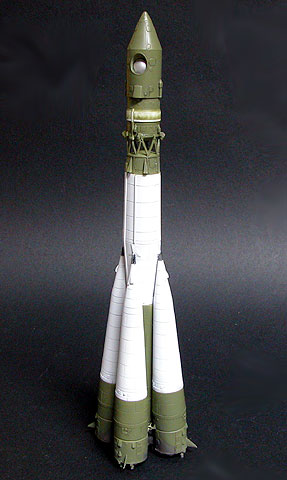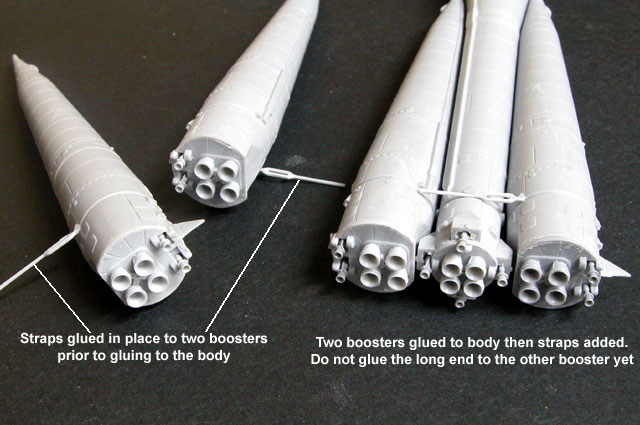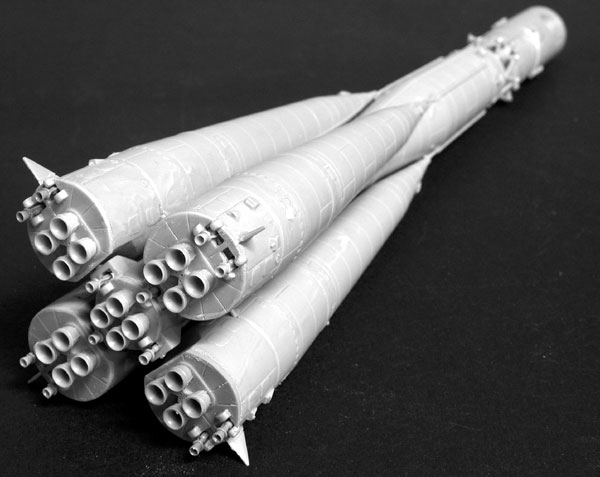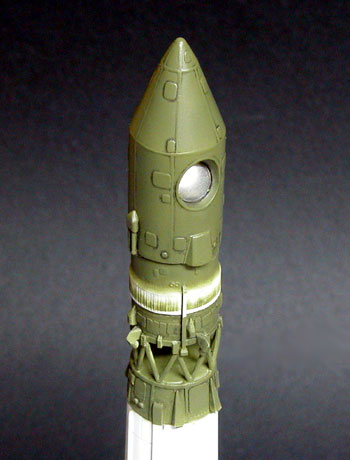|
Vostok & R-7 Booster
by Brett Green

Cutting Edge's 1/144 Scale Vostok is available
online from Meteor Productions
 Background Background
The Vostok spacecraft carried Soviet Cosmonaut Yuri Gagarin on
the first manned space flight on 12 April, 1961. Gagarin completed one orbit of
the earth before a troublesome re-entry and ejection from the Sharik sphere,
completing his journey by parachute.
The Space Race had begun.
The Vostok spacecraft was based on the Soviet R-7
Intercontinental Ballistic Missile. This design undertook eleven launches
between December 1960 and June 1963.
Cutting Edge's 1/144 Scale Vostok
Cutting Edge has launched into the field of real space models
with the Vostok and R-7 Booster in 1/144 scale. This is Cutting Edge's first
model in the Lift Off series.
The model comprises 34 pieces in grey resin. Generous quantities
of spare parts are also supplied, boosting the
contents of the package. Casting quality is very high, especially considering
the size and weight of the individual castings. There were a few tiny,
cauliflower-shaped casting scars on the larger parts, but these were easily
sliced off and sanded down. Despite careful packaging, two of the stabiliser
fins on my Vostok had broken in transit. Two spots of superglue resolved this
problem.
Click on the thumbnails below to
view larger images:
The main body of the rocket and the R-7 boosters are very
substantial lumps of resin. These are complimented by some delicate castings of
the "V" shaped supports for the third stage, small nozzles and the interleaving
straps that secure the booster units.
I have never built a Real Space model before, but I was intrigued
by this model. I liked the characteristic Soviet appearance of the strap-on
boosters, and the large clean resin castings tempted me as soon as I opened the
box.
Construction starts with preparation of the resin parts.
The large parts are attached to correspondingly large casting
blocks. A razor saw is the appropriate tool for this job. I took plenty of time
to ensure a straight cut because the base plate for each booster and the main
rocket require a perfectly flat surface for a gap-free bond. When the blocks
were removed, I sanded the bottom of the parts in preparation for the base
plates.
Smaller parts can be removed from their casting blocks with a
hobby knife and cleaned up with a sanding stick, but care will be required with
a few items. In particular, the "V" shaped interstage parts need to be handled
with care. I nibbled away the majority of the resin flash between the arms of
each "V" with a set of sprue cutters, then finished the preparation with a new
knife blade.
Although there was an impressive pile of waste resin following
cleanup, the entire preparation took no more than an hour and a half.
Click on the thumbnails below to
view larger images:
|
|

|
|
The straps were cut off with a sharp hooby blade then carefully cleaned up
|
|

|
|
The excess resin between the "V" shaped supports for the third stage was nibbled away with sprue cutters then finished with a knife
|
|

|
|
The cleanup results in an impressive pile of waste resin!
|
|
|
Assembly proceeded quickly once the parts were prepared. The
base plates were glued to the bottom of the main rocket body and to each of the
boosters. I drilled out individual holes for each of the separate small nozzles
and glued them in place. In retrospect, I should have waited until the boosters
were glued to the body before securing the small nozzles. That way, I could have
adjusted the precise height of each nozzle to ensure they all touched the ground when
the rocket was in the vertical position.
Attaching the boosters and threading the interleaving straps is
probably the most challenging aspect of construction. The instructions suggest
that the boosters should be glued in place then the straps threaded between the
boosters and the body. This method seemed to offer little margin for error. I
therefore decided on the following
process:
Step 1: Glue two boosters to the main body - one
each on opposite sides.
Step 2: Glue the yoke end only of one strap to each of
the boosters.
Step 3: Glue the yoke end of a strap to each of the
remaining loose
boosters. Make sure that the straps will be parallel to the ground (taking into
account the angle of the boosters) and at a 90°
angle to the "flat spot" at the bottom of the boosters.
Step 4: Carefully lift the rod end
of one of the straps connected to the rocket and thread the end of the rod
through the yoke of one of the loose boosters. Push the rod between gap, then
glue the loose booster in place.
Step 5: Repeat Step 4 for the
remaining loose booster.
Step 6: Glue the four loose rod
ends to the boosters.
This might sound complicated but it
should make sense when the parts are laid out in front of you. The image below
shows the rods and boosters with Step 3 (above) completed, ready for threading
and final assembly:

The Vostok
third stage parts were glued together. A few gaps were filled with Liquid Paper and
Gunze Mr Surfacer before being sanded.
The next demanding task is the
alignment and installation of the "V" interstage supports. These are supplied
as
two semi-circular halves. A spare semi-circle is also provided in case of disaster. Locating holes are
recessed into the top of the main body, so I decided to install the two delicate
resin parts here first. The "V" supports rested nicely on top of the locating
holes and against each other. It was only after I had glued the third stage on
top of this assembly that I noticed that it was slightly crooked.
I tried to avoid dismantling the
entire assembly by trimming a couple of the legs of the "V" supports
while they were glued in place. This was
working well until I popped the third stage off the
body of the rocket while sanding on of the mounts. I took this as an omen and made a more meaningful
correction, this time adding the "V" struts to the bottom of the third stage and sanding the
bottom of the struts until they were flat. A spot of super glue on the bottom of
each "V" secured the third stage to the body of the rocket.
Assembly was completed with the
addition of small vents on the upper part of the main rocket.

Prior to building the Cutting Edge model, I had precious little
knowledge of Vostok and no idea about colour schemes. I did a quick search on
the Internet and found a website with a great colour photo of a Vostok in
a scheme of green and white. You can visit the web page by following
this link
http://www.astronautix.com/lvs/vos8k72k.htm .
That looked good enough to me!
I had a couple of options for the sequence of painting. It would
be easiest to pre-paint the parts before final assembly, but the painted parts would inevitably
suffer from fingerprints and super glue marks before completion. On the
other hand, complex masking might be required if I decided to paint the model
after assembly. In the end, masking seemed to be the lesser of the two
evils.
Click on the thumbnails below to
view larger images:
|
|

|
|
The central part of the model was painted Flat White and the base sprayed with Burnt Metal Buffing Metalizer
|
|

|
|
The borders between the white and the green were masked with Tamiya masking tape. A narrow band on the third stage was also masked.
|
|

|
|
Green was sprayed on the bottom of the boosters and the top of the rocket. Following this, "Post It Note" masks were stuck to the booster.
|
|

|
|
Green was then sprayed on the main body between the boosters...
|
|

|
|
...resulting in a clean demarcation line on boosters and body.
|
|
|
The white in the photograph appears to be dead flat. I first
sprayed the body of the model Flat White, and then sprayed Testor's Burnt Metal
Buffing Metalizer on the base of the Vostok. Tamiya Masking Tape was used to
define the border between the white and the green. I chose Green FS 34102 as the
second colour. This displays a noticeable sheen in the photo.
 A
small section of the Sharik re-entry sphere is exposed at the top of the third
stage. This circle was sprayed with Aluminum Metalizer then masked with a blob
of Blu-Tack. A
small section of the Sharik re-entry sphere is exposed at the top of the third
stage. This circle was sprayed with Aluminum Metalizer then masked with a blob
of Blu-Tack.
The reference photo also shows an irregular white band part way up the
third stage. I assume this is actually icing, not paint, but I wanted to depict
it too. I masked a hard line at the bottom of the band, but applied a soft
demarcation at the top. I also airbrushed a streaky band of green inside the
white band per the photo.
I originally intended to mask the metallic paint at the base of
the rocket too, but I got a nice sharp demarcation line by freehand spraying.
After the green paint had been applied to the top of the rocket
and the bottom of the boosters, I stuck self-adhesive "Post-It Notes" to the
boosters to mask them in preparation for spraying the green sections of the
lower main body. This resulted in a clean demarcation line for both the main
body and the boosters.
The Blu-Tack mask for the silver circle was removed and the tips of the
booster mounts were brush-painted with Burnt Metal Metalizer.
Finally, a thin black oil wash was applied to the surface details on the
green parts of the rocket. The white parts did not require any additional
highlighting - the crisp recessed detail looked good as it was.
|
Home
| What's New |
Features |
Gallery |
Reviews |
Reference |
Forum |
Search